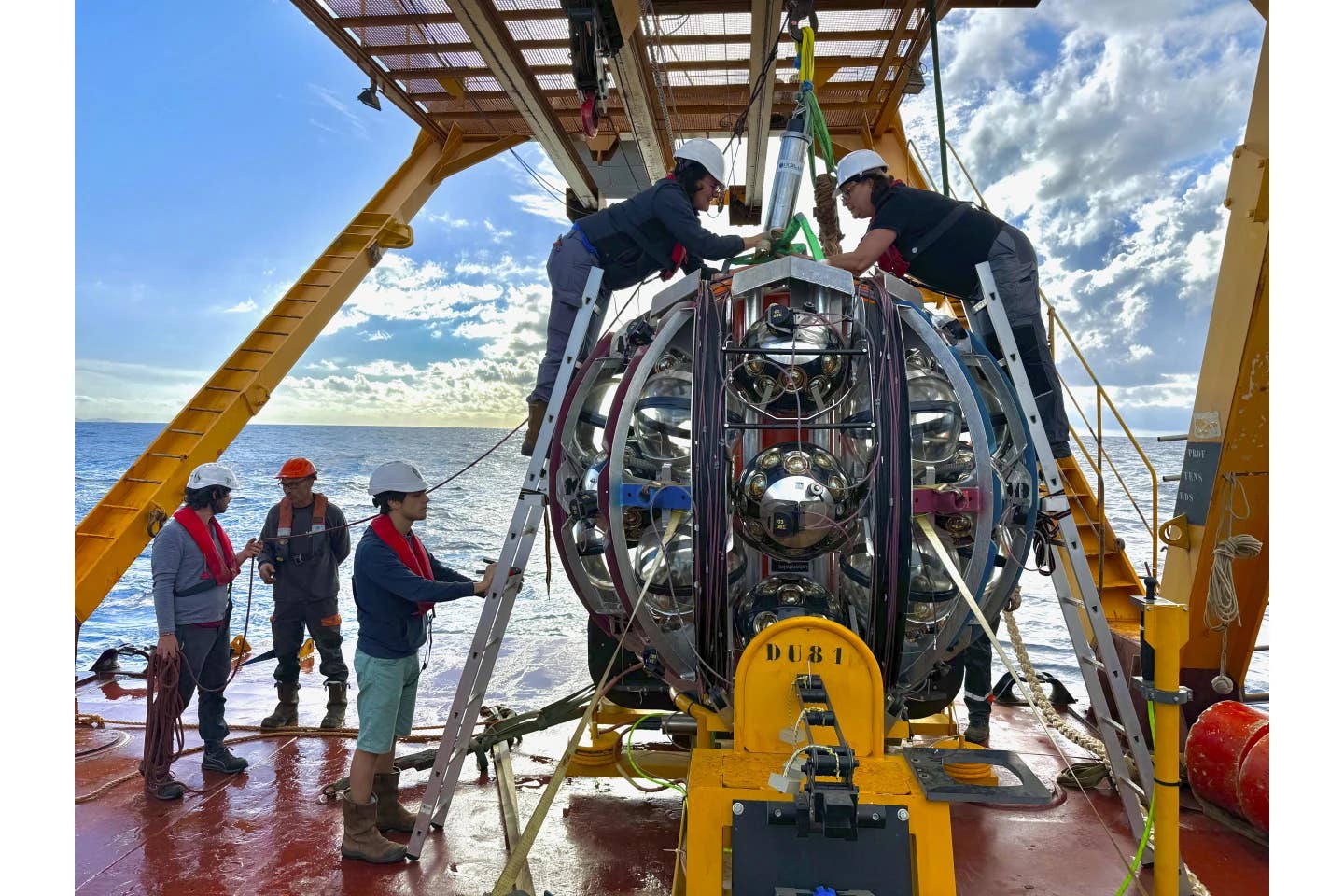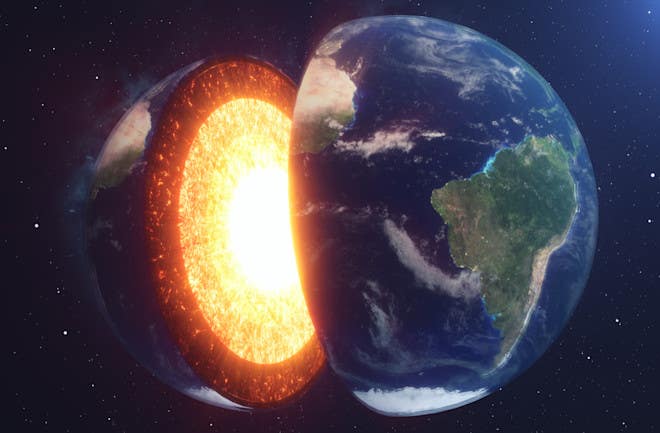Scientists detect the most energetic neutrino ever recorded
Scientists detect a record-breaking 220 PeV neutrino deep in the Mediterranean Sea, revealing new insights into the universe’s most powerful events.

Scientists prepare to lower equipment used to detect neutrinos into the Mediterranean Sea. (CREDIT: Paschal Coyle, KM3NeT)
In the vast expanse of the cosmos, powerful cataclysmic events unleash streams of high-energy particles. Among them are neutrinos—ghostly subatomic particles that travel unimpeded through space, carrying unique insights into the most extreme astrophysical phenomena.
Unlike other cosmic messengers, neutrinos barely interact with matter, making them exceptionally difficult to detect. Yet, on February 13, 2023, an extraordinary event occurred deep in the Mediterranean Sea.
A neutrino with an estimated energy of 220 peta-electron volts (PeV) was detected by the ARCA detector of the KM3NeT neutrino telescope. This energy level far surpasses any neutrino previously observed, marking a breakthrough in astrophysics. After meticulous analysis, researchers confirmed their findings in a paper published in Nature on February 12, 2025.
“KM3NeT has begun to probe a range of energy and sensitivity where detected neutrinos may originate from extreme astrophysical phenomena. This first-ever detection of a neutrino of hundreds of PeV opens a new chapter in neutrino astronomy and a new observational window on the Universe,” said Paschal Coyle, spokesperson for KM3NeT at the time of the discovery.
Neutrinos and Their Cosmic Origins
Neutrinos are second only to photons as the most abundant particles in the universe, yet they remain elusive. With no electric charge and almost no mass, they interact so weakly with matter that they can pass through entire planets without leaving a trace. But when one does interact, it generates a burst of energy, revealing crucial clues about its origin.
Most neutrinos detected on Earth come from cosmic rays striking the atmosphere. These atmospheric neutrinos form a background that makes it difficult to isolate cosmic neutrinos—those born from astrophysical sources such as supernovae, black holes, and gamma-ray bursts.
Some neutrinos arise when cosmic rays interact with the cosmic microwave background, producing ultra-high-energy "cosmogenic" neutrinos. Identifying the origin of these particles provides a glimpse into the universe’s most energetic and mysterious events.
Related Stories
“Neutrinos are one of the most mysterious elementary particles. They have no electric charge, almost no mass, and interact only weakly with matter. They are special cosmic messengers, bringing us unique information on the mechanisms involved in the most energetic phenomena and allowing us to explore the farthest reaches of the Universe,” explained Rosa Coniglione, deputy spokesperson of KM3NeT and a researcher at the National Institute for Nuclear Physics in Italy.
How the Deep-Sea Detector Caught an Elusive Particle
Detecting neutrinos requires massive observatories capable of capturing the rare moments when they interact with matter. KM3NeT, a deep-sea neutrino telescope under construction, uses the Mediterranean Sea as its detection medium.
When a neutrino collides with a water molecule, it produces charged particles that emit Cherenkov light—a faint bluish glow. Specially designed optical sensors capture these flashes, allowing scientists to reconstruct the neutrino’s properties.
KM3NeT consists of two detectors: ARCA, optimized for high-energy cosmic neutrinos, and ORCA, designed to study neutrino oscillations. ARCA, located 3,450 meters beneath the sea near Sicily, will eventually contain 230 vertical detection lines, each equipped with 18 spherical optical modules housing photomultiplier tubes.
ORCA, positioned off the coast of France at a depth of 2,450 meters, will comprise 115 detection lines. Together, they will provide an unprecedented view of the universe’s most energetic processes.
The neutrino detected in 2023, named KM3-230213A, passed through the ARCA detector, producing signals in more than one-third of its sensors. Its trajectory, combined with its enormous energy, strongly indicated an extraterrestrial origin. Such high-energy neutrinos are believed to emerge from interactions near cosmic-ray sources or from the decay of secondary unstable particles along cosmic-ray paths.
“To determine the direction and energy of this neutrino required a precise calibration of the telescope and sophisticated track reconstruction algorithms. Furthermore, this remarkable detection was achieved with only one-tenth of the final configuration of the detector, demonstrating the great potential of our experiment for the study of neutrinos and for neutrino astronomy,” said Aart Heijboer, KM3NeT’s physics and software manager and a researcher at the National Institute for Subatomic Physics in the Netherlands.
What This Discovery Means for Astrophysics
This record-breaking neutrino could be a direct signal from a powerful cosmic accelerator or the first detection of a cosmogenic neutrino. Determining its origin, however, requires further data. With only one event observed, scientists cannot yet conclude whether it emerged from a supermassive black hole, an exploding star, or a yet-unknown cosmic phenomenon.
As KM3NeT expands, with more detection units and increased sensitivity, it will capture additional high-energy neutrinos. These observations will help identify their sources and refine our understanding of particle acceleration in the cosmos.
The discovery also strengthens the emerging field of multi-messenger astronomy, which combines data from neutrinos, gravitational waves, and electromagnetic signals to paint a more complete picture of extreme astrophysical events.
“The scale of KM3NeT, eventually encompassing a volume of about one cubic kilometer with a total of about 200,000 photomultipliers, along with its extreme location in the abyss of the Mediterranean Sea, demonstrates the extraordinary efforts required to advance neutrino astronomy and particle physics.
The detection of this event is the result of a tremendous collaborative effort between many international teams of engineers, technicians, and scientists,” said Miles Lindsey Clark, KM3NeT’s technical project manager.
While neutrinos remain some of the universe’s most enigmatic particles, each new detection brings scientists closer to answering profound questions about the origins of cosmic rays, the nature of black holes, and the extreme processes shaping the universe.
With instruments like KM3NeT, the future of neutrino astronomy looks promising, opening the door to discoveries that were once thought impossible.
Note: Materials provided above by The Brighter Side of News. Content may be edited for style and length.
Like these kind of feel good stories? Get The Brighter Side of News' newsletter.
Joshua Shavit
Science & Technology Writer | AI and Robotics Reporter
Joshua Shavit is a Los Angeles-based science and technology writer with a passion for exploring the breakthroughs shaping the future. As a contributor to The Brighter Side of News, he focuses on positive and transformative advancements in AI, technology, physics, engineering, robotics and space science. Joshua is currently working towards a Bachelor of Science in Business Administration at the University of California, Berkeley. He combines his academic background with a talent for storytelling, making complex scientific discoveries engaging and accessible. His work highlights the innovators behind the ideas, bringing readers closer to the people driving progress.



